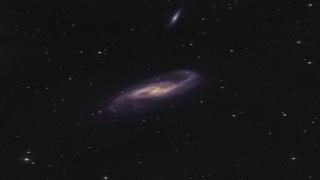Bibcode
Pan, Hsi-An; Lin, Lihwai; Hsieh, Bau-Ching; Barrera-Ballesteros, Jorge K.; Sánchez, Sebastián F.; Hsu, Chin-Hao; Keenan, Ryan; Tissera, Patricia B.; Boquien, Médéric; Dai, Y. Sophia; Knapen, Johan H.; Riffel, Rogério; Argudo-Fernández, Maria; Xiao, Ting; Yuan, Fang-Ting
Referencia bibliográfica
The Astrophysical Journal, Volume 881, Issue 2, article id. 119, 14 pp. (2019).
Fecha de publicación:
8
2019
Revista
Número de citas
62
Número de citas referidas
58
Descripción
Galaxy interaction is considered a key driver of galaxy evolution and
star formation (SF) history. In this paper, we present an empirical
picture of the radial extent of interaction-triggered SF along the
merger sequence. The samples under study are drawn from the integral
field spectroscopy survey SDSS-IV MaNGA, including 205 star-forming
galaxies in pairs/mergers and ∼1350 control galaxies. For each
galaxy in pairs, the merger stage is identified according to its
morphological signatures: incoming phase, at first pericenter passage,
at apocenter, in merging phase, and in final coalescence. The effect of
interactions is quantified by the global and spatially resolved SF rate
(SFR) relative to the SFR of a control sample selected for each
individual galaxy (Δlog SFR and Δlog sSFR(r), respectively).
Analysis of the radial Δlog sSFR(r) distributions shows that
galaxy interactions have no significant impact on Δlog sSFR(r)
during the incoming phase. Right after the first pericenter passage, the
radial Δlog sSFR(r) profile decreases steeply from enhanced to
suppressed activity for increasing galactocentric radius. Later on, SF
is enhanced on a broad spatial scale out to the maximum radius we
explore (∼6.7 kpc) and the enhancement is in general centrally
peaked. The extended SF enhancement is also observed for systems at
their apocenters and in the coalescence phase, suggesting that
interaction-triggered SF is not restricted to the central region of a
galaxy. Further explorations of a wide range in parameter space of
merger configurations (e.g., mass ratio) are required to constrain the
whole picture of interaction-triggered SF.
Proyectos relacionados

Las Galaxias Espirales: Evolución y Consecuencias
Nuestro grupo pequeño esta bien conocido y respetado internacionalmente por nuestro trabajo inovativo e importante en varios aspectos de la estructura y la evolución de las galaxias espirales cercanas. Usamos principalmente observaciones en varias longitudes de onda, explotando las sinergías que nos permiten responder a las cuestiones más
Johan Hendrik
Knapen Koelstra